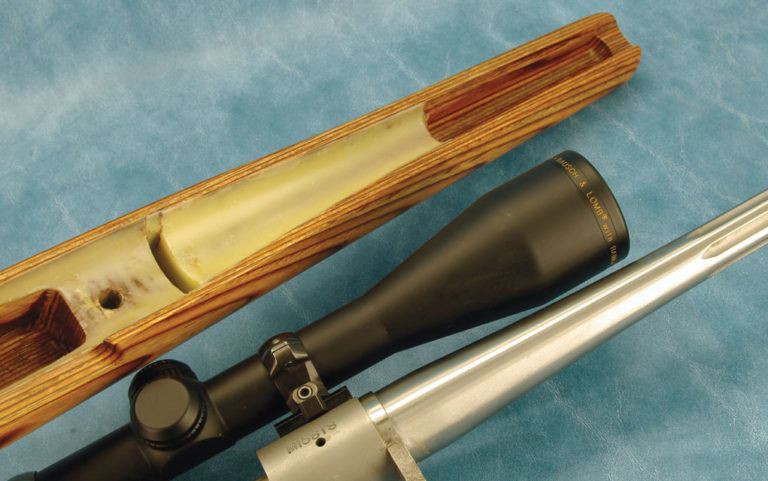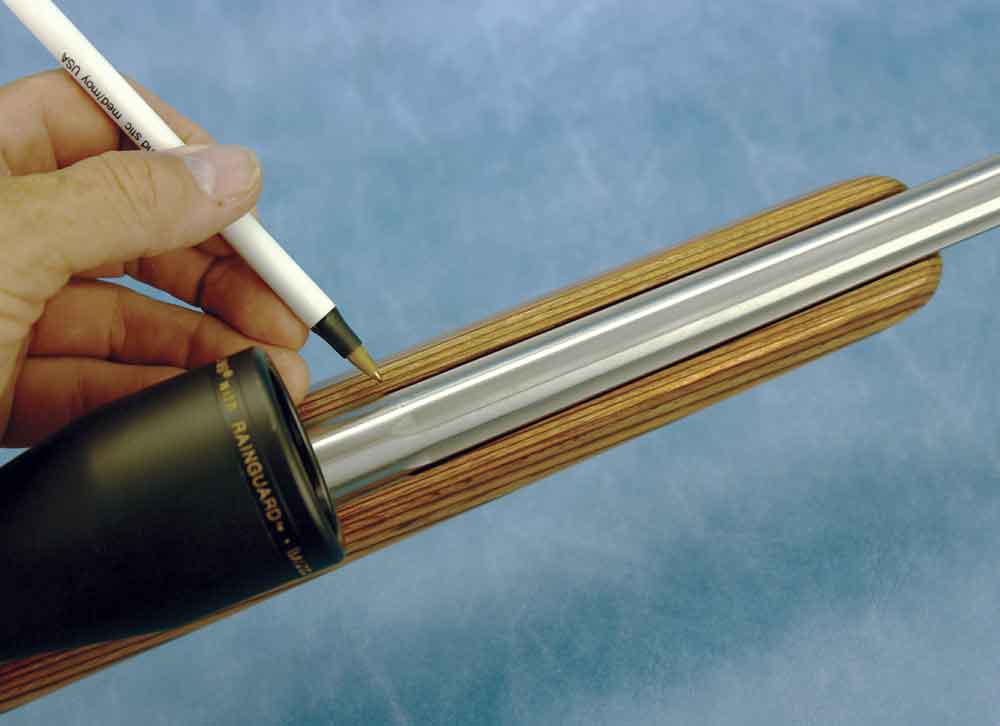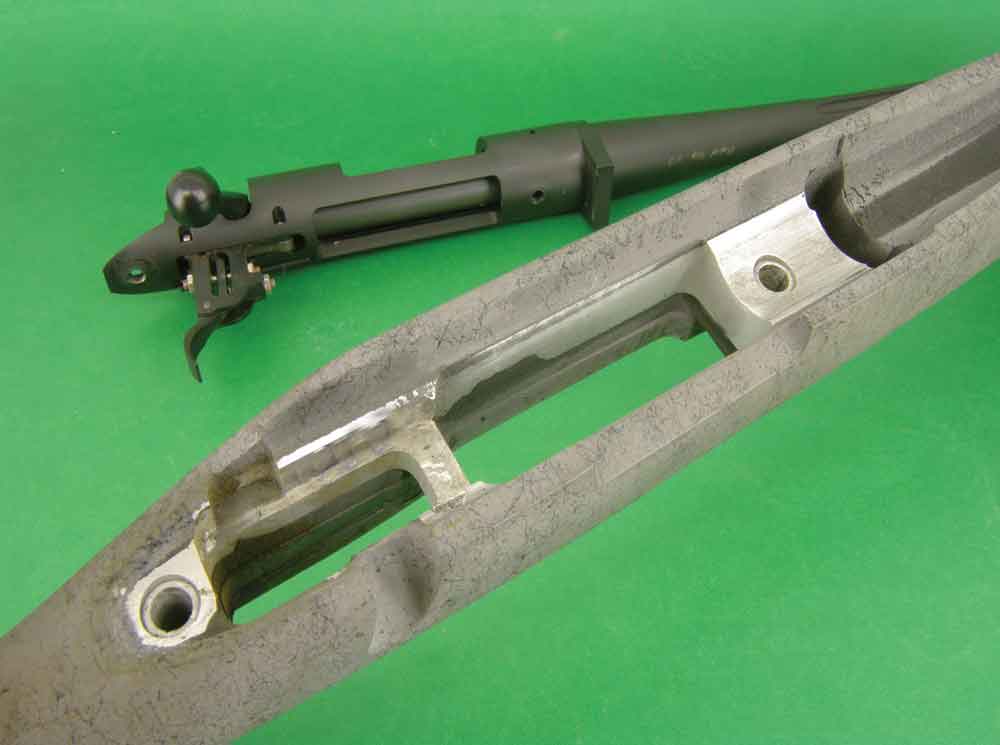
Not all barrel bedding is equal. Bedding dynamics can increase or decrease a rifle's accuracy.
What are some things to know about bedding dynamics and accuracy?
- Today, generally the most common bedding method is to bed the receiver and free float the barrel.
- To get the best accuracy from a rifle, you need the pressure dynamic between the barrel and stock to remain constant, or as constant as possible. This can sometimes vary quite a bit in a traditional wood-stocked rifle based on things like temperature and humidity.
- Pillar bedding and V-Block bedding are two alternative bedding systems that are growing in popularity among manufacturers.
There are many factors that affect accuracy, but next to the barrel itself, none is more important than the bedding dynamics between the stock and the barreled action. Accuracy can be looked at from two different perspectives: 1) pure grouping ability and 2) a rifle’s ability to maintain zero.
The two are not the same. Pure grouping ability refers to how tight the average group measures, regardless of where that group is on the target, while a rifle’s ability to maintain zero refers to the point of impact (POI) relative to where we as a shooter expect it to be. In a hunting rifle, consistent POI is more important than pure accuracy.
There are a number of ways a bolt-action rifle can be bedded. Bull barrels and heavy varmint/target barrels vibrate less violently upon the fall of the firing pin, ignition and bullet movement than sporter-weight versions, and generally shoot just as well when free floated as they do when bedded.

The most common method employed today by production rifle manufacturers is to bed the receiver and free float the barrel. This practice has evolved over the past generation or so, as one-piece stocks of walnut (or other hardwoods) have been replaced by much more stable synthetics and wood laminates. This method is not used because free floating has proven superior in all cases, but rather, it’s because it’s easier from a manufacturing standpoint.
Generally speaking, slender, lightweight barrels shoot best when there’s dampening pressure being exerted by the stock either at the forend tip or by contact over the entire length of the forend. Most light carbine and sporter-weight rifles are bedded using the former approach.
By hogging out the barrel channel to where it’s 1/16-inch or more deeper and wider than it has to be, but stopping an inch or so short of the forend tip, the remaining raised band provides the dampening pressure at the tip. When the forward action screw is cinched up, the stock is actually bowed inward, and that is what produces the tension against the barrel.
Dampening barrel pressure can also be exerted the entire length of the barrel channel, but to accomplish that you must have perfect surface contact the entire length of the forearm, which is best achieved through glass bedding.
For a rifle to group its best and maintain zero, the pressure dynamic between the barrel and stock must remain constant, particularly in the case of lightweight barrels that are being dampened only at the forend tip. Traditional one-piece stocks of walnut have proven to be fairly good at keeping this pressure relationship constant, as long as the wood is thoroughly sealed not only on the outside, but on all inlet surfaces as well.
If truth be told, though, all wood stocks have at least a 5 percent moisture content, so it’s pretty rare for a one-piece stock to maintain a constant tip pressure against the barrel from season to season, or when the rifle is transported to a region where the humidity is vastly different. Then, too, the thinner the barrel, the more POI and accuracy are both affected by the forend position, whether on a sandbag or held in the hand, whether a shooting sling is being used to apply dynamic tension to steady the rifle, or if a bipod is attached to the forend.

Stock Swell
I know it’s difficult to believe that a chunk of wood like a rifle stock can swell, contract and warp, but they all do to some degree depending on seasonal humidity, or when subjected to drenching rain or wet snow. As to just how much a stock can warp, that can be seen only on a rifle that has a fully floated barrel, that is, with a visible space along the seam line on both sides of the barrel.
I have owned some walnut-stocked guns in which the barrel would be perfectly centered in the channel during the low humidity months of winter, and in the summer the forend tip would be touching the barrel on one side with a 1/8-inch gap on the other. Depending on the direction of the warp, imagine how much pressure such movement exerts or removes from a barrel.
Believe me when I say there can be as much as 30 to 40 pounds of pressure on the barrel at one time of year, and zero at another. That, of course, is an extreme example, but changes of just a few pounds of tip pressure against or away from the barrel can bring about significant shifts in POI.
Can accuracy and consistency of zero be achieved with a one-piece wood stock? Sure, but several conditions have to be just right, and the thinner the barrel, the more difficult it becomes.
It’s far easier to achieve with a wood laminate or a synthetic stock, with the barrel either fully or partially floated. A wood laminate that is properly sealed inside and out with a urethane-type finish is virtually immune to warping, and a laid-up stock of fiberglass or Kevlar is definitely so. If the bedding is right, it stays right.
Like I said, the most common bedding approach used today is to glass bed the receiver and float, or partially float, the barrel. I prefer the latter, in which the receiver and the chamber portion of the barrel are bedded, stopping at the point where the barrel begins its straight taper to the muzzle. Placing a small shim the thickness of a matchbook cover at the forend tip prior to the bedding procedure will ensure a fully floated barrel.
Slender barrels — say less than .575-inch at the muzzle — tend to group best when the stock is exerting dampening pressure. If after range testing you’d like to see how the rifle shoots with dampening pressure, simply place two shims at the forend tip.

A couple of alternate bedding systems we’re starting to see more manufacturers take advantage of include pillar bedding and V-block bedding. With a true pillar-bedded rifle, the receiver actually sits on two “stilts” of aluminum or steel, and there is no actual contact between the stock and the receiver or barrel.
The pillars are nothing more than steel tubes through which the action screws pass and are just slightly longer in length than the action screw holes. The pillars are flush or slightly below the bedding surface of the receiver and serve primarily to preclude stock compression.
The V-block system, which was developed by H-S Precision for the Army’s M24 sniper rifle, consists of a hardened aluminum bedding chassis permanently molded into the company’s hand-laid Kevlar/graphite-reinforced fiberglass stocks. The latest twist to the V-block principal can be seen in Ruger’s American and Savage’s Axis rifles.
Steel blocks are embedded into the injection molded stocks and serve to support the receiver and act as recoil lugs by engaging grooves on the underside of the receiver. Either makeup is meant to provide economy of production, but more importantly, consistency to that critical relationship between a rifle’s stock and its barreled action.
Editor's Note: This article is an excerpt from the May 2015 issue of Gun Digest the Magazine.

Next Step: Get your FREE Printable Target Pack
Enhance your shooting precision with our 62 MOA Targets, perfect for rifles and handguns. Crafted in collaboration with Storm Tactical for accuracy and versatility.
Subscribe to the Gun Digest email newsletter and get your downloadable target pack sent straight to your inbox. Stay updated with the latest firearms info in the industry.









WONDERFUL EXPLANATION JUST WONDERFUL!!!!!! I HAVE BEEN SAYING THESE THINGS MYSELF AND TOTALLY 100 PERCENT AS I AM NOT A PROFFESIONAL BUT I HAVE SHOT 100’S OF THOUSANDS OF ROUNDS IN MY LIFE AND HAVE ACTUALLY BROKE A FEW WORLD RECORDS THAT DONT COUNT BECAUSE WERE NOT RECORDED DURING COMPETITION KEN S WRIGHT